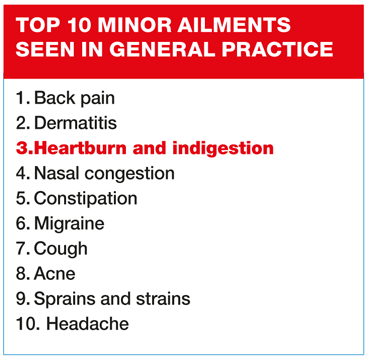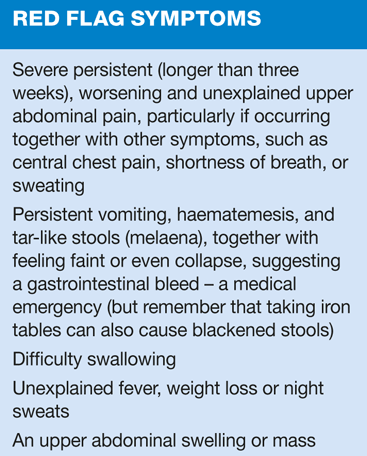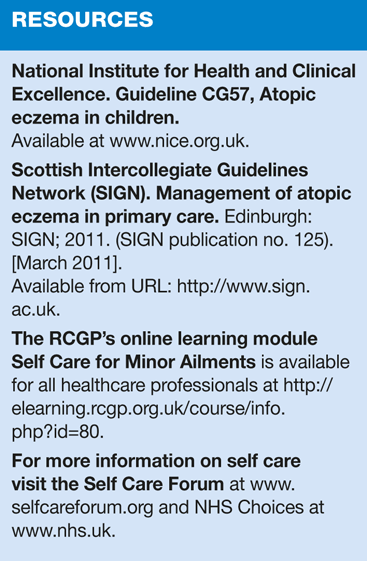Dyspepsia (indigestion) and heartburn
Dr Knut Schroeder
Dr Knut Schroeder
FRCGP
GP, Concord Medical Centre, Bristol, and Honorary Senior Clinical Lecturer in Primary Health Care, University of Bristol, Self Care Forum Board member and author of 'Diagnosing Your Health Symptoms For Dummies' &
Sara Richards, RN
Specialist Primary Care Nurse, Practice Nurse Facilitator, Berkshire
Self Care Forum Board member
Minor ailments account for 20% of primary care consultations in the UK every year, and of these, 6.8 million are for dyspepsia and heartburn. Yet these minor ailments can be managed effectively through self care. This article summaries the information to share with patients about these symptoms
WHAT ARE DYSPEPSIA AND HEARTBURN?
Dyspepsia (or indigestion) and heartburn are symptoms of pain or discomfort in the upper abdomen or chest. They often occur after meals, and are commonly accompanied by belching, feeling bloated and nausea. This can be the result of overeating, eating high fat meals or being overweight. Common causes include:
- Gastro-oesophageal reflux disease (or GORD) which describes acid reflux and oesophagitis
- Drugs, such as non-steroidal anti-inflammatory drugs (NSAIDs), steroids, bisphosphonates or nitrates
- Helicobacter pylori (or H. pylori) infection
- Hiatus hernia.
Less commonly, peptic ulcer or gastric or oesophageal cancer may be responsible. Dyspepsia without a known cause is called functional dyspepsia.
HOW COMMON IS IT?
Upper gastrointestinal symptoms may affect up to 4 out of 10 people in any one year. Half of these people self-medicate with or without advice from a pharmacist. About 25% of sufferers consult their general practitioner.
WHAT CAN PATIENTS EXPECT?
In about 8 out of 10 people, symptoms will improve by making lifestyle changes alone - healthier eating, in particular, and losing weight. The most common diagnosis is functional dyspepsia, in which no specific underlying cause can be found. In uncomplicated dyspepsia, patients can expect symptoms to improve with over-the-counter (OTC) medication.
WHAT CAN PEOPLE DO TO HELP THEMSELVES?
Various factors can cause or exacerbate indigestion. Advise patients to avoid fatty and fried meals, and eating large meals at night. Avoiding carbonated soft drinks, coffee and alcohol may also help. Reducing or, ideally, stopping smoking and achieving a healthy weight not only relieve symptoms, but also lead to wider health benefits.
WHICH OTC PREPARATIONS CAN PEOPLE USE?
Various antacids (such as aluminium hydroxide and magnesium carbonate, hydroxide and trisilicate), alginates (such as sodium alginate) and compound alginate preparations are available OTC at pharmacies, in petrol stations and in supermarkets. H2-receptor antagonists, such as ranitidine, and proton pump inhibitors (PPIs), such as omeprazole and pantoprazole, are also widely available (PPIs only from pharmacies). These medicines should not be taken for prolonged periods without consulting a health professional. If OTC NSAIDS are being taken regularly, a health professional should be consulted in case these could be the cause of the indigestion.
WHEN SHOULD PATIENTS RETURN?
Patients may present after two-to-four weeks, as per the advice given on OTC medicines' labels. Unless patients suffer from red flag symptoms (see box), they can be advised to continue with their self care choices. Patients should seek medical advice if their symptoms do not respond to treatment, or if their symptoms worsen.
WHAT ARE THE NEXT STEPS?
If patients do not respond to OTC medicines, then prescription-strength PPIs, given for one month, may help alleviate symptoms. Testing for H. pylori can be performed through a stool sample, a blood test, or a breath test (making sure that PPIs are stopped for at least two weeks before the test). Patients testing positive for H. pylori should be offered eradication therapy, which involves taking a PPI and two types of antibiotics, either metronidazole and clarithromycin or amoxicillin and clarithromycin, usually for one week. Second line treatments include H2-receptor antagonists, such as ranitidine, and prokinetics, such as metoclopramide or domperidone. The presence of red flag symptoms should prompt urgent GP assessment and possible referral for oesophago-gastro-duodenoscopy.
SUMMARY
Dyspepsia and heartburn are common symptoms in primary care. Patients can relieve symptoms by taking various OTC medicines and by avoiding exacerbating factors. The presence of red flags should prompt urgent medical assessment.
Related articles
View all Articles



